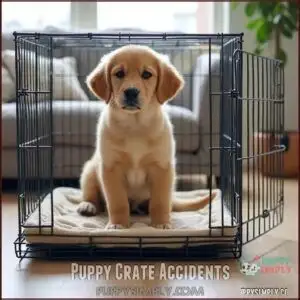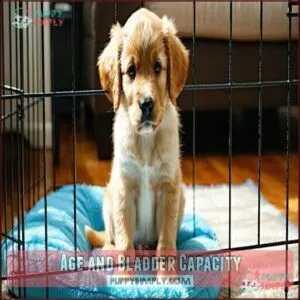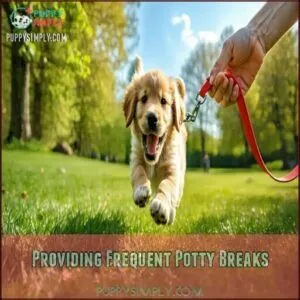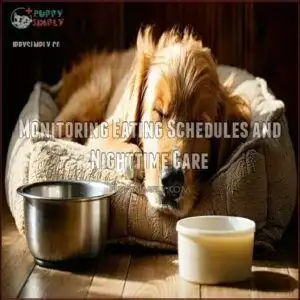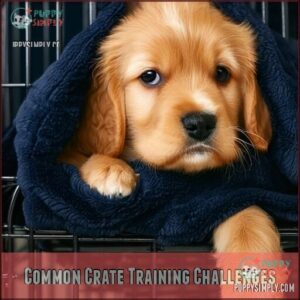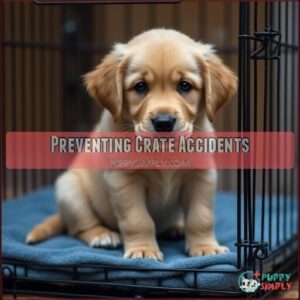This site is supported by our readers. We may earn a commission, at no cost to you, if you purchase through links.
 Finding your puppy peeing in his crate isn’t just annoying—it’s a cry for help. Your pup might have a medical issue like a UTI, or the crate could be too large for proper training.
Finding your puppy peeing in his crate isn’t just annoying—it’s a cry for help. Your pup might have a medical issue like a UTI, or the crate could be too large for proper training.
Make certain you’re taking him out frequently enough (puppies can only hold their bladder for about one hour per month of age). Check that you’re cleaning accidents thoroughly with enzyme cleaners, as lingering smells invite repeat business.
Create a consistent schedule for feeding, watering, and potty breaks. Sometimes the solution is as simple as adjusting your timing—or as complex as addressing anxiety issues that have your furry friend feeling all wet, which can be a complex problem to solve, and requires a consistent approach.
Table Of Contents
- Key Takeaways
- Puppy Crate Accidents
- Crate Training Essentials
- Managing Puppy Potty Needs
- Common Crate Training Challenges
- Preventing Crate Accidents
- Frequently Asked Questions (FAQs)
- At what age do puppies stop having pee accidents?
- How do I get my puppy to stop peeing in his crate?
- Is it normal for my puppy to pee in her crate?
- What age do puppies stop peeing in a crate?
- Why is my dog regressing and peeing in his crate?
- Why does my puppy pee in the crate after peeing outside?
- Why does my puppy keep peeing and pooping in his crate?
- How long does it take to break a puppy of crate accidents?
- What are the best chew toys to prevent crate soiling?
- Can I use pee pads in the crate to manage accidents?
- Conclusion
Key Takeaways
- You should rule out medical issues like UTIs or underlying conditions before assuming it’s a training problem – watch for unusual urine appearance, discomfort during elimination, or frequent attempts with little output.
- You’ll need to ensure your puppy’s crate is properly sized – it should be just large enough for them to stand, turn around, and lie down, as too much space encourages creating a "bathroom corner."
- You must establish a consistent schedule with frequent potty breaks based on your puppy’s age (typically one hour per month of age plus one) and take them out immediately after meals, play, and frequent potty breaks.
- You’ll get better results by cleaning accidents thoroughly with enzyme cleaners that completely eliminate odors, as lingering scents can trigger repeat accidents in the same spot, which requires immediate attention and proper cleaning to prevent future accidents.
Puppy Crate Accidents
You’ll likely feel frustrated when your puppy has accidents in their crate, but understanding the causes will help you solve this common problem.
Puppies may urinate in their crates due to medical issues, improper crate size, insufficient potty breaks, or anxiety, all of which can be addressed with the right approach.
Medical Issues and Health Concerns
When your puppy has accidents in his crate, medical issues could be lurking beneath the surface. Various health conditions, from anatomic abnormalities to incontinence causes, might explain why your furry friend can’t maintain bladder control.
Before assuming it’s a training issue, consider these warning signs:
- Unusual urine appearance (cloudy, dark, or containing blood)
- Frequent attempts to urinate with little output
- Visible discomfort or whimpering during elimination
Don’t wait for symptoms to worsen—schedule a veterinary checkup immediately. Some medications can also increase urination frequency as a side effect. Underlying illnesses require professional diagnosis and treatment. Addressing urinary tract infections is essential for pet health.
Urinary Tract Infections
When your furry friend keeps having crate accidents, a urinary tract infection (UTI) might be the culprit.
UTI symptoms include frequent urination, painful peeing, unusual urine smell, and blood-tinged discharge.
If you notice these signs, schedule a vet checkup immediately.
Diagnosing UTIs requires urinalysis and possibly cultures to identify the specific bacteria.
After treatment with antibiotics, your puppy should stop having accidents.
To prevent recurring UTIs, make certain your pup has constant access to fresh water and regular potty breaks.
Medical issues like these require prompt attention—don’t blame your puppy, as they can be caused by underlying conditions such as a urinary tract infection.
Underlying Medical Conditions
When your puppy consistently pees in their crate, underlying medical conditions might be the culprit.
Diabetes, kidney problems, and Cushing’s disease can cause frequent urination. UTI symptoms include straining and dark urine, while incontinence causes involuntary leaking.
Spinal cord injuries may reduce bladder control, and certain medications have side-effects that increase thirst and urination. Senior dog issues like prostate problems also contribute to accidents.
Don’t delay—a veterinary diagnosis through a vet checkup will identify the proper treatment for your puppy’s issue, and it’s crucial to address the problem promptly to ensure the health of your pet.
Crate Training Essentials
Master crate training essentials by creating a sanctuary, not a prison.
Your puppy’s crate should be just large enough for them to stand, turn around, and lie down comfortably.
Introduce the crate gradually with treats, toys, and positive reinforcement.
Make it cozy with appropriate bedding and cover it partially to create a den-like environment where your puppy feels secure, reducing anxiety-related crate accidents.
Managing Puppy Potty Needs
You’ll need to take into account your puppy’s age and bladder capacity when managing their potty needs during crate training.
Your consistent schedule of frequent breaks, especially after meals and naps, will help prevent accidents and build positive bathroom habits, which is crucial for successful crate training with frequent breaks.
Age and Bladder Capacity
Understanding your puppy’s bladder capacity is key to preventing crate accidents.
The golden rule for puppy bladder control is simple: their age in months plus one equals the maximum hours they can hold it.
Your puppy’s bladder control limit? Their age in months plus one hour—simple math for accident-free crating.
A 2-month-old puppy needs breaks every 3 hours, while a 4-month-old can typically last 5 hours.
This "monthly rule" applies day and night during early development.
| Puppy Age (Months) | Holding Capacity (Hours) | Overnight Care Needed? | Notes |
|---|---|---|---|
| 2 | 3 | Yes | Frequent potty breaks |
| 3 | 4 | Yes | Take out every 4 hours |
| 4 | 5 | Occasionally | Growing bladder control |
| 5+ | 6+ | Rarely | Longer holding capacity |
Patience is essential—your puppy’s nighttime capacity will improve with age-appropriate crating and development, following the golden rule for effective puppy training and ensuring proper care.
Providing Frequent Potty Breaks
Building on understanding bladder development, setting up frequent potty breaks is your next essential step.
Your puppy needs scheduled outings every 1-2 hours during the day, particularly after meals, playtime, and naps. Establish consistent timing with a reward system for successful outdoor elimination.
Don’t forget overnight breaks—even young pups need midnight potty trips. Monitoring intake helps predict when nature will call.
A well-planned potty schedule dramatically reduces puppy accidents and reinforces proper crate training habits through predictable routines.
Monitoring Eating Schedules and Nighttime Care
Now that you’ve established a potty break routine, let’s tackle mealtimes.
Feed your puppy at consistent times daily, scheduling dinner at least 3 hours before bedtime.
Remove water 2-3 hours before sleep to prevent nighttime accidents.
Positive reinforcement techniques can further encourage successful potty breaks.
Create a bedtime ritual with a final potty trip outside.
Wake up early for an immediate morning bathroom break, reinforcing your puppy’s potty schedule and preventing crate accidents.
Common Crate Training Challenges
You’ll face several common obstacles when crate training your puppy, from anxiety issues to incorrect crate sizing that can trigger accidents.
Understanding these challenges helps you address the root causes of crate soiling and implement effective solutions that work with your puppy’s natural instincts, which can lead to successful crate training.
Separation Anxiety and Emotional Factors
Why might your puppy be turning their crate into a puddle? Separation anxiety could be the culprit.
When puppies experience distress from being alone, their bodies respond physically.
- Filming behavior while you’re away can identify puppy anxiety triggers
- Creating a "puppy palace" setup helps reduce isolation distress
- Doggie daycare offers social interaction that prevents separation anxiety
- Behaviorist consult may be necessary for severe dog anxiety cases
Gradually increase alone time, using treats and toys to build positive crate associations. Addressing this issue often requires dog separation anxiety training.
Improper Scheduling and Dietary Changes
Your puppy’s accidents in the crate often stem from irregular routines and dietary changes. When you disrupt their feeding schedule or introduce new foods, their little bladders can’t keep up.
Many owners find success with a structured feeding plan.
To minimize accidents, consider the following strategies:
- Maintain consistent mealtimes to regulate potty breaks
- Remove water bowls 2-3 hours before bedtime to reduce nighttime accidents
- Introduce new foods gradually to avoid stomach upset and dietary irritants, ensuring a smooth transition to new foods.
Crate Size and Environmental Factors
While adjusting your puppy’s feeding schedule is important, crate size can make or break your housetraining success.
The right crate dimensions prevent your pup from creating a "bathroom corner" separate from their sleeping area.
Your puppy’s crate should allow them to stand, turn around, and lie down—nothing more.
| Crate Factor | Impact | Solution |
|---|---|---|
| Size | Too large encourages peeing | Use crate divider |
| Bedding | Can absorb odors | Consider temporary removal |
| Placement | Affects security | Create a safe space |
To manage crate size effectively, consider using a crate sizing solution to ensure you’re providing the best environment for your puppy’s development and housetraining success.
Preventing Crate Accidents
You can prevent your puppy from having accidents in the crate by establishing a consistent schedule and using the right crate size.
Taking your puppy outside for potty breaks before crating and removing water a few hours before bedtime will help avoid those frustrating middle-of-the-night messes, which can be prevented with a well-planned routine.
Effective Cleanup Strategies and Pet-Safe Cleaners
After addressing training challenges, proper cleanup becomes your next line of defense. When your puppy has an accident, thorough cleaning prevents repeat offenses by eliminating scent markers.
- Use enzyme cleaners specifically formulated to break down urine molecules completely
- Apply odor neutralization products immediately after removing visible moisture
- Select disinfecting crate solutions without harsh chemicals that might irritate your pup’s sensitive nose
- Rinse thoroughly and dry completely before reintroducing bedding
Remember, what smells clean to you might still signal "bathroom" to your puppy. White vinegar works in a pinch, but dedicated enzymatic cleaners are your best weapon against stubborn stains and lingering odors.
Limiting Crate Size and Removing Bedding
When your puppy treats their crate like a bathroom, size matters. A properly sized crate should only allow enough space for your furry friend to stand, turn around, and lie down comfortably.
Use dividers to adjust the space as they grow, preventing the "bedroom vs. bathroom" situation. If crate soiling persists, try temporarily removing bedding—puppies naturally avoid messing where they sleep.
Don’t worry about comfort concerns; most puppies prefer clean sleeping quarters over plush bedding soaked in urine. Different crate materials may also influence cleanup ease.
Establishing a Daily Schedule and Potty Routines
Beyond properly sizing your puppy’s crate, establishing a rock-solid daily schedule is your secret weapon against accidents.
Set consistent meal times each day, followed immediately by scheduled potty breaks.
Remember the golden rule: puppies can only hold it for their age in months plus one hour.
Create a reliable nighttime routine with limited water before bed, and always reward success with positive reinforcement during housebreaking.
Frequently Asked Questions (FAQs)
At what age do puppies stop having pee accidents?
Rome wasn’t built in a day, and neither is bladder control.
Most puppies gain reliable control between 4-6 months, but you’ll see gradual improvement from 8 weeks as they develop physically and mentally.
How do I get my puppy to stop peeing in his crate?
Make certain your crate’s properly sized, establish a consistent potty schedule, take frequent breaks, and rule out medical issues.
Clean accidents thoroughly with enzymatic cleaners.
Don’t punish your puppy – reward successful outdoor elimination instead, as this approach is more effective in promoting good behavior and successful training.
Is it normal for my puppy to pee in her crate?
Like a tiny house guest without a key to the bathroom, your puppy’s crate accidents are normal for young dogs.
They’re still developing bladder control and learning house rules.
It’s a phase they’ll outgrow.
What age do puppies stop peeing in a crate?
Most puppies gain reliable crate control between 4-6 months of age.
You’ll see improvement as their bladder muscles develop and training takes hold.
Some may need until 7-8 months for complete reliability.
Why is my dog regressing and peeing in his crate?
Your furry friend isn’t plotting revenge through puddles.
Medical issues, stress, improper crate size, changes in routine, or inadequate potty breaks could be causing your dog’s regression.
A vet check is recommended.
Why does my puppy pee in the crate after peeing outside?
Your puppy may pee in the crate after going outside due to incomplete elimination, anxiety, or bladder development issues.
Younger puppies can’t fully control their bladders yet and might need more time outside, which can help with incomplete elimination.
Why does my puppy keep peeing and pooping in his crate?
Up against the wall with potty problems?
Your puppy may be soiling his crate due to medical issues, anxiety, improper crate size, insufficient potty breaks, or incomplete house training.
A vet check is recommended.
How long does it take to break a puppy of crate accidents?
Most puppies need 4-8 weeks of consistent training to stop crate accidents.
You’ll see progress faster if you establish regular potty breaks, use proper crate sizing, and maintain a consistent feeding schedule.
What are the best chew toys to prevent crate soiling?
Like a child with a coloring book, your pup needs focus.
Durable rubber toys like Kongs filled with treats keep them busy.
Mental stimulation diverts attention from peeing accidents, satisfying their chewing instincts instead, and this can be achieved with durable rubber toys.
Can I use pee pads in the crate to manage accidents?
While you can use pee pads temporarily, they may confuse your training efforts. It’s better to address the root cause through proper scheduling, crate sizing, and consistent bathroom breaks.
Conclusion
According to veterinary experts, 70% of puppies will have at least one crate accident during training.
Remember, solving issues with your puppy peeing in his crate takes patience and consistency.
Identify the root cause—whether medical, scheduling, or anxiety-related—and address it directly.
Maintain proper cleaning protocols, adjust crate size appropriately, and stick to regular potty breaks.
You’ll soon have a dry, comfortable pup who views his crate as a safe haven rather than a bathroom.

